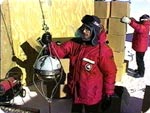|

How
do you track a particle that leaves no footprints?
by Liza Gross

|

|
|
|
Photo:
John
Jacobsen
|
|
|
Preparing
to lower one of AMANDA's light sensors into the ice.
|
|
|
|
"The
hope is that the particle that is almost nothing will tell
us almost everything about the universe."
Francis Halzen, principal investigator
of the AMANDA detector
Researchers
on the trail of the neutrino—the subatomic "ghost" particle
notorious for leaving no trace—have cast ever-wider nets
to apprehend it. But none of those efforts rival the scale
or ingenuity of the ice-bound detective of the Antarctic,
AMANDA.
With a mission as ambitious as its construction, AMANDA (Antarctic
Muon and Neutrino Detector Array) is a collaborative enterprise
involving fifteen universities and science institutes from
the United States and Europe. Designed to find evidence of
black holes and other deep-space phenomena, this improbable
observatory carved into the deep ice of the South Pole promises
to advance our understanding of the evolution of the universe.
Neutrino
Fundamentals
Neutrinos,
like quarks and electrons, are elementary particles, fundamental
building blocks of matter. But, unlike their subatomic cousins,
neutrinos have no electric charge, nearly no mass, and little
affinity for matter. You can't see neutrinos, but you can
tell they've been around by the wreckage they leave behind.
Like any particle with no charge, neutrinos can be detected
only when their interactions produce charged particles. Although
a neutrino interaction is rare, when it does happen, it can
produce a negatively charged particle called a "muon." Because
that muon moves along the same path as the incoming neutrino
did, researchers can tell which direction the neutrino came
from by examining the muon's trail.
|
